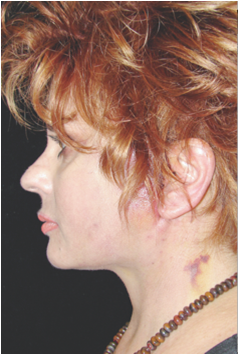QuickLift™:Separating Fact From Fiction In Less Invasive Facelift Surgery(3)
COMPLICATIONS:I often tell my patients that there is no real comfort in numbers because even if there is a 1or 2 percent chance of a certain complication, it is 100 percent if it happens to you. The reality of that is often difficult for the patient to understand. It is human nature to want to blame something or someone for a problem. However, with the complexity of the human body and the healing variables there within, complications WILL occur. It is not a subject that is typically dwelled on by patient or the doctor, since the chances of a significant complication are rare, but it is part of the patient’s decision and should be discussed before surgery.
Figure. QuickLiftTM With Significant Post-Procedure Bruising and Swelling; After Healing.
 Discoloration days post-procedure.
Discoloration days post-procedure.
 Patient same day with hair camouflaging area.
Patient same day with hair camouflaging area.
 QuickLift™:Weeks later, after healing resolved.
QuickLift™:Weeks later, after healing resolved.
In my experience, and in the medical literature, the most common complications occur within the first 48 hours:hematoma, poor circulation (usually along the incision, which can lead to some scabbing and a wider healing scar or necrosis, also known as skin death), swelling and bruising. These complications are certainly manageable, and part of the process. In these situations, it is vital that the patient not panic. When the patient is completely compliant — listening to and following the physician’s instructions for follow-up care — it makes all the difference in the world.
Why I wrote this article
I want to close this article by explaining some important points about the benefits of less invasive procedures. Because we have developed a consistent, repeatable means of performing this surgical procedure, we are able to share it with other talented surgeons who can perform it in their own practices. In sharing the QuickLift™ with the profession, I am first training fellow surgeons in a specific medical procedure that, given the individual facts of a specific patient’s own medical condition, has proven over time to be repeatable from patient to patient, with great benefits to patients who are right for the procedure. But in three decades of practice, I’ve learned it’s not enough for doctors to talk to each other about procedures that can make a great difference in patients’ lives. You must also explain to patients why a particular procedure might be beneficial to them, and also, what risks or complications they might face. This is why I wrote this article. I want potential patients to understand the benefits and risks of this procedure, which could be beneficial to them. I want to help patients make the best choice for them. Aging is a fact of human existence. In the 21st century, in our society, good health, nutrition and modern medicine have us living longer, more fruitful lives. Yet far too many of us present a face to the world that doesn’t reflect how we feel on the inside, or the facts of our physical health. Less invasive facelift surgery such as the QuickLift™ can help us present a true picture of ourselves to the world.
If you are evaluating this kind of procedure for yourself, or for someone you love, I hope I have helped you to separate fact from fiction, and develop a true understanding of what you need to know about “quick” when it comes to facelift surgery.

Figure. A Visual Comparison of Facelift Procedures.



 留言列表
留言列表
